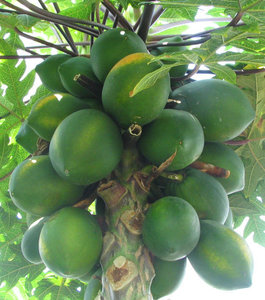
Pinyin:Fan Mu Gua Latin: Carica Papaya
Physical Characteristics
The papaya (from Carib via Spanish), is the fruit of the plant Carica papaya, in the genus Carica. It is native to the tropics of the Americas, and was cultivated in Mexico several centuries before the emergence of the Mesoamerican classic cultures.*
Papaya is sometimes called "tree melon" or "pawpaw," but the North American pawpaw is a different species, in the genus Asimina. It is a large tree-like plant, the single stem growing from 5 to 10 meters tall, with spirally arranged leaves confined to the top of the trunk; the lower trunk is conspicuously scarred where leaves and fruit were borne. The leaves are large, 50-70 cm diameter, deeply palmately lobed with 7 lobes. The tree is usually unbranched if unlopped. The flowers are similar in shape to the flowers of the Plumeria but are much smaller and wax like. They appear on the axils of the leaves, maturing into the large 15-45 cm long, 10-30 cm diameter fruit. The fruit is ripe when it feels soft (like a ripe avocado or a bit softer) and its skin has attained an amber to orange hue. The fruit's taste is vaguely similar to pineapple and peach, although much milder without the tartness.*
Family
Edible Uses*
The ripe fruit is usually eaten raw, without the skin or seeds. The unripe green fruit of papaya can be eaten cooked, usually in curries, salads and stews.*
Traditional Chinese Medicinal (TCM) Uses*
The mature (ripe) fruit treats ringworm, green fruits treat high blood pressure, and are used as an aphrodisiac. * The fruit can be directly applied topically to skin sores. The juice of the fruit (specifically the enzymes within it) are used to reduce gastrointestinal gas, useful to sufferers of IBS. The seeds are anti-inflammatory, anthelmintic, and analgesic, and they are used to treat stomachache and fungal infections. The leaves are used as a heart tonic, analgesic, and to treat stomachache. * The roots are used as an analgesic.*
References
Source: Carica Papaya Fan Mu Gua
Natural dietary supplements are designed to offer the body support to promote health, harmony, balance and overall well being.*

 Get Well Natural, LLC
Get Well Natural, LLC  Kidney Function & Regeneration Health
Kidney Function & Regeneration Health  Platelet & Blood Cell Health
Platelet & Blood Cell Health  Prostate, Flow & Function Health
Prostate, Flow & Function Health  General Mind & Body Health
General Mind & Body Health  Heart, Cholesterol & Cardio Health
Heart, Cholesterol & Cardio Health  Allergy-Free Body
Allergy-Free Body  Anxiety & Stress
Anxiety & Stress  Blood Platelet Counts & Function
Blood Platelet Counts & Function  Blood Pressure Health
Blood Pressure Health  Kidney Function Health
Kidney Function Health  Immune System Health & Balance
Immune System Health & Balance  Prostate & Urinary Health Function
Prostate & Urinary Health Function  Blood Sugar Balance
Blood Sugar Balance  Cardiovascular Heart Health
Cardiovascular Heart Health  Detoxification & Healthy Cells
Detoxification & Healthy Cells  Women's Health
Women's Health  Liver Regeneration
Liver Regeneration  Pain-Free Body
Pain-Free Body  Water & Air Filtration
Water & Air Filtration 


